Read Witchcraft Medicine: Healing Arts, Shamanic Practices, and Forbidden Plants Online
Authors: Claudia Müller-Ebeling,Christian Rätsch,Ph.D. Wolf-Dieter Storl
Witchcraft Medicine: Healing Arts, Shamanic Practices, and Forbidden Plants (56 page)

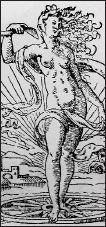
A personification of the witch with instruments of torture.
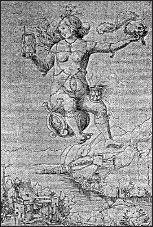
The naked woman with the hourglass and the skull could be an allegory of time. But the title that has been handed down is
Hexe, den Schädel Manuels durch die Lüfte tragend
(Witch, Who Carries the Skull of Emmanuel through the Air). (Niklaus Manuel Deutsch, pen and ink, Kunstmuseum, Bern, c. 1513.)
There where the lust is coveted my kingdom is also increased where boys of Venus go to meet her box is taken up but the box is only lust and joy and from it comes the greatest woe.
62
In 1668 Johannes Praetorius was witness to how vivid the worship of “Frau Venus, who was the most noble and decried nymph of all the spirit-beings” still prevailed among the Saxons in Magdeburg. He described how they carried an image of Venus through the streets on a wagon—and he did not forget to include the fact that she was naked.
Her head is crowned with myrtle, on her breast she carried a burning torch, in her right hand the globe of the earth, and in her left three golden apples. After her came the three graces. … It had once been in the mountains, caves, and cliffs, where often great arches and caves were found, where she had her home, congregation, and armies. Friday
63
is in particular the best suited among the days for a ghost to appear in a small body. … Her movement is like the most beautiful and brightest star
64
(Praetorius, 1979: 139).
“Aphrodite and materia, Venus and nature are sysnonumous and interchangeable terms. … The goddess is omnipresent and animates nature with her desires and instincts.”
—P
ETER
G
ERLITZ
,
M
ENSCH UND
N
ATUR IN DER
W
ELT-RELIGIONEN
[M
AN AND
N
ATURE IN THE
W
ORLD’S
R
ELIGIONS
], 1998
Despite these words of praise the author did not forget to include a moral warning: Those who fall prey to Venus’s seductions must recognize that she is only a ghost.
Particularly revealing about Praetorius’s exposition of these heathen customs is that Aphrodite was obviously still at home in the wild places of nature—indeed she had never left. These are the very same places whose hellish characters appear in the nocturnal scenes of pictures from the Netherlands on the themes of the witches’ kitchen and of the temptations of Saint Anthony. Praetorius’s description of the naked Venus with long hair, the globe, and other attributes evokes an image of the feminine personification of sensuality, of sumptuousness, or of the unpredictable nature of Fortuna, the goddess of fate. Later generations had a difficult time identifying the individual allegories when they were not clearly labeled, for it was not rare that both Fortuna and Venus, as well as Lust, were models for the witch.
Characterizations such as nakedness and long, unbound hair and attributes such as thistles, skulls, and goats could indicate that these were representations of witches; but those attributes could also have to do with Venus, Sin, Luxuria, or Fate. The 1513 drawing by Niklaus Manuel Deutsch (1484–1530) titled
Hexe, den Schädel Manuels durch die Lüfte tragend
[Witch, Who Carries the Skull of Emmanuel through the Air] shows a nude on a globe with a feather-decorated death’s head and an hourglass that flies through the air.
Despite the unbearable “lust and joy” that came from a goddess such as Venus and flowed abundantly from Pandora’s box, the Renaissance man had to grapple with a difficult demand, for the gods and goddesses in the rediscovered texts of antiquity maintained a strangely ambiguous attitude that defied the contemporary dichotomies that viewed everything as either good or evil—these gods and goddesses were good
and
evil. For example, Aphrodite/Venus was a love goddess as well as a death goddess, as Karl Kerényi demonstrated in his
Mythologie der Griechen
[Mythology of the Greeks].
65
To the Christians, who looked to the classical sources with renewed interest at the beginning of the modern era with the intention of blending this knowledge with Christian concepts, according divine characteristics to the gods and goddesses of antiquity was simply too much to ask. Christianity knows only one God. In Venus’s nicknames Melaina and Melainis, “the Black One,” are references to her dark aspect; these became crystallized in the image of the witch.
66
We have noted the prevalent theme of the witch riding on a goat. The impetus for that image likely comes from Sappho, the Greek poet from the sixth century B.C.E., who also sings of Aphrodite as a flying goddess.
67
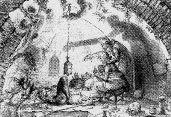
In pictures from earlier centuries, caves and decaying ruins are depicted as evidence of heathen times. A frightening impression of those times is shown in the scenes of hell, the witches’ kitchen, and the witches’ sabbat. These scary images also appear in scenes of the temptation of Saint Anthony, where the heathen areas are depicted as a hotbed of bats, monstrously deformed people, and aged witches who mix dreadful ingredients into ruinous mixtures. (Jacob de Gheyn II, Frankfurter Goethemuseum, Freies Deutsches Hochstift, 1600.)
Deathless Aphrodite of the spangled mind, child of Zeus, who twists lures, I beg you do not break with hard pains, O lady, my heart … yoking your chariot. And fine birds brought you, quick sparrows over the black earth whipping their wings down the sky through midair—
d
Diana
When we imagine the witches’ nocturnal ride through the air to the dance site, the image of the Roman hunt goddess Diana comes to mind. In 907 C.E. in the
Canon Episcopi
we can read: “It should also not be overlooked that certain criminal women perverted by Satan, seduced by illusions and phantasms of demons, believe and openly profess that, in the dead of night, they ride upon certain beasts with the pagan goddess Diana, with a countless horde of women, and in the silence of the night fly over vast tracts of the country, and obey her commands as their mistress, while they are summoned to her service on other nights.”
68
The hunters waited for her command and took care that certain killing and sacrificial rites were maintained; if they were not upheld, she could become very unpleasant.
In Christian art Diana commands “the wild army,” as Urs Graf represented her in his painting
Das wilde Heer
. She was depicted on intaglios, in bronzes, and in stone sculptures of the Roman imperial times as the Lady of the Animals, usually in the company of dogs, lions, and especially stags. In this way she offered a fitting model for the witch, who is shown in the company of ravens, cats, and owls. A comparison of the paintings of Diana’s hunt with images of the witches’ sabbat reveals both subjects to be similar in their portrayals of the orgiastic activities of naked women in the middle of a usually wooded natural setting.
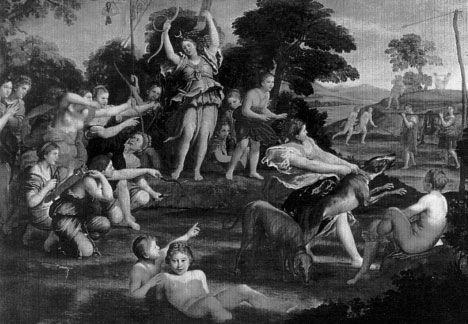
Since the Renaissance, Diana, whom the Italian Sabines saw as a goddess of fertility, guardian of wild animals, and protector of birth for humans and animals, has nourished artists’ fantasies of wild feasts in the countryside with naked women. This goddess also enriched the repertoire of the witches’ sabbat. (Domenico Zampiere [Domenichino, 1581–1641], Rome, Galleria Borghese.)

The goddess Natura (who is the same as Venus or Aphrodite) sits with her cornucopia, surrounded by plants, on the banks of a river in which Neptune is swimming with his trident. A Roman supplicant is turned toward her. On the back side of this book illustration the first line, “Oh Holy Goddess Earth, she who brings the natural things forth …,” was replaced with “Oh Holy God …” in the Middle Ages. (Illustration from
Medicina antiqua,
Libri IIII medicine,
Codex vindobonensis
93: fol. 9.4., early 13th century.)
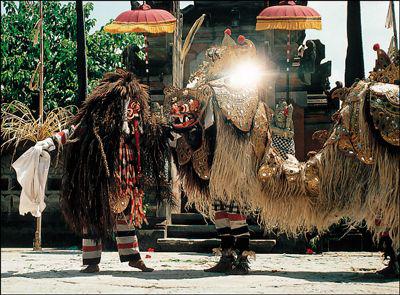
The Barong dance on the island of Bali presents both sides of the world. The left side symbolizes the negative aspect, the dragon on the right the positive side of the universe. The dance reveals to the audience that neither side has more power and neither side can win. (Photograph by Claudia Müller-Ebeling.)
